JANUARY 27, 2020—75th Anniversary of the Liberation of Auschwitz
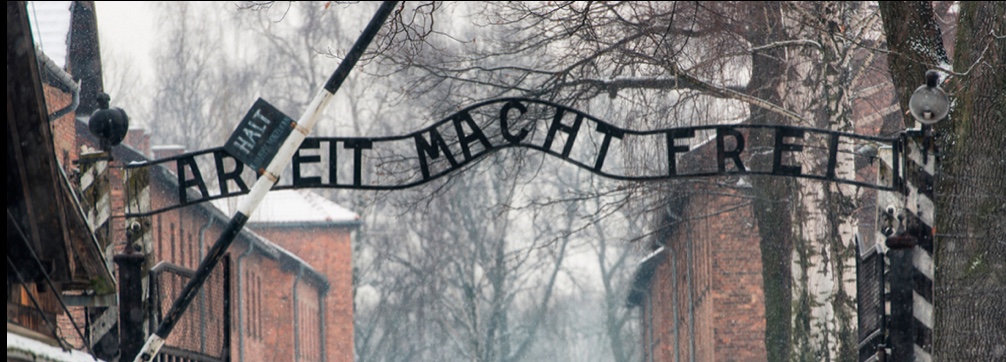
Momentous day, especially at Auschwitz and at the United Nations.
On Monday January 27th, commemorations took place all over the world, remembering that unforgettable day in 1945, when Soviet troops marched into Auschwitz-Birkenau. They expected to find the German army; instead they found sick and dying prisoners. The number of prisoners liberated on January 27th was actually quite small (7,000), compared with the number of Jews NOT liberated on that day (In addition to the 1.1 million murdered there, 60,000Jews had already been forced out of Auschwitz-Birkenau, Poland’s most famous concentration camp).
On January 17, 1945, those 60,000 prisoners—weak, starving, freezing, with nothing but rags on their backs to protect them—were forced out of Auschwitz-Birkenau, trudging to other slave labor camps in the German Reich. With conditions so brutal and the prisoners so week and ill-equipped to survive the frigid Polish winter, it is no wonder that over 15,000 died on what has come to be known as the Death March. What is miraculous is that ANY of them survived at all!
If they hesitated or stumbled, they were summarily shot. Remarkably, I’ve heard countless stories from prisoners, who could barely walk themselves, who somehow found the strength to help other prisoners whose strength was already gone. One such hero was George Horner, himself less than 5’ tall, who carried a bigger man, for the distance it took his friend to revive sufficiently so he could start to take steps on his own. George’s act saved the other man’s life and the two remained friends, until the end of their days. [To learn more about the last days of Auschwitz-Birkenau, please click here]
In actuality, it was only those 7000 Jews who were too weak to walk or who were already so close to death that they didn’t care what the Nazis did to them—Only these Jews who were liberated at Auschwitz-Birkenau!
Despite the limited numbers, this event was still enormously significant, and worthy of the major commemorations taking place world-wide. One of the most illustrious was held (of course) at Auschwitz-Birkenau in Poland (It was attended by Luis Ferreiro, Head of Musealia, whose organization commissioned the incredible exhibit, “Auschwitz—Not Long Ago, Not Far Away”, which can currently be seen at the Museum of Jewish Heritage).
The ceremony I attended took place at the United Nations, with the Secretary General, delegates to the UN, Holocaust Survivors, and WWII veterans, in attendance. I was with two Second Generation friends, Abe Krieger, (former) Chief Counsel for the World Gathering of Holocaust Survivors and Rositta Kenigsberg, Co-Founder of the International Network of Children of Holocaust Survivors, and Head of Holocaust Documentation Center.
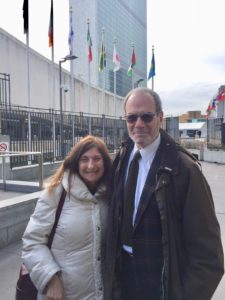
Ann and Abe Krieger, Counsel for World Gathering of Holocaust Survivors
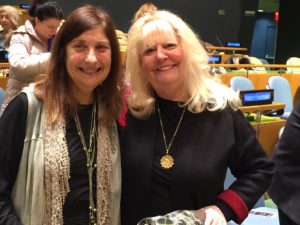
Ann and Rositta Kenigsberg, Co-Founder of International Network of Children of Holocaust Survivors
We heard inspiring words from the Secretary General of the UN, Antonio Guterres, as well as from Permanent Representatives of Russia, Israel, Germany, and United States (Temporary) Representative.
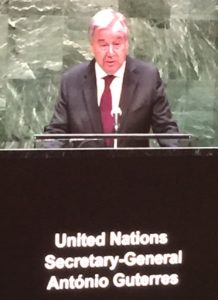
Secretary General of the UN Antonio Guterres
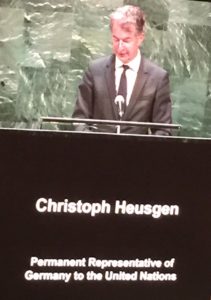
German Representative, Christoph Heusgen
For me, it was the German Representative, Christoph Heusgen, whose remarks hit home the strongest. He talked about the cataclysmic events during WWII that were caused by his country, events that nearly destroyed the world, and he also talked about the measures Germany has taken since WWII to try to avoid anything similar ever happening again. As most of us know, Germany’s laws against Hate Speech are the strictest in the world, and yet, despite everything, he sadly affirmed, that despite everything that Germany has been doing for decades, there was still an alarming increase in Anti-Semitism in his country! This dangerous trend has also been increasing throughout the world, including in our own United States and in much of Europe, as well.
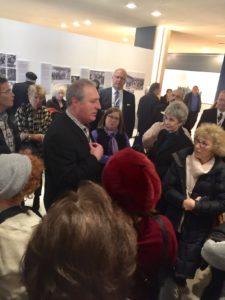
Paul Salmons leading tour at UN exhibit
After these formal ceremonies concluded, Abe and I attended a special lecture (also attended by the Secretary General) and premiere of a new photo exhibition at the United Nations, curated by Paul Salmons. Titled “Seeing Auschwitz”, it includes the heartbreaking photos of the Hungarian Jews just hours before they were murdered, four rare photos taken by the Sonderkommando, as well as an aerial photo of Auschwitz, proving that the Allies could easily have bombed Auschwitz. (which, for years, they strongly denied)—an act that could have saved many lives. For me, it was very exciting that this special exhibit also includes the personal family photos that populate my book, The Last Album: Eyes from the Ashes of Auschwitz-Birkenau, and are featured in my own traveling exhibition. (In Poland, they can also be seen at the Sauna in Birkenau). This special exhibit, which was created exclusively for the United Nations’ 75th Anniversary of Auschwitz Liberation, will be on display until late February. [To learn more about this new exhibit, which has just finished its run at UNESCO headquarters in Paris, please click here. For the exhibit website click Seeing Auschwitz ].
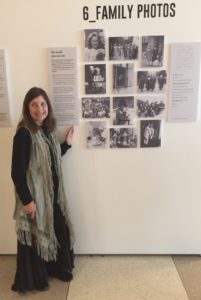
Ann with Family Photos, from her book, The Last Album, in exhibit at the United Nation, titled “Seeing Auschwitz”
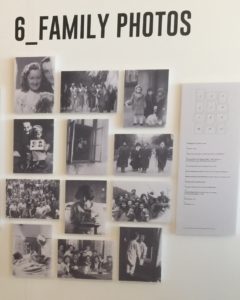
Closeup of Family Photos, from UN exhibit
This day of commemoration was only just starting! Now Abe and I raced to the Museum of Jewish Heritage in Battery Park for a much anticipated lecture by Robert Jan Van Pelt, Chief Curator of the stupendous exhibit, “Auschwitz—Not Long Ago, Not Far Away.” RJ explained how he organized the exhibit, his considerations on HOW to tell this complicated story, what artifacts to include (and what to omit), how to best display them, and how to convey the message most effectively to viewers of diverse backgrounds and knowledge. It was an eye-opening and fascinating lecture, made only more so by Robert Jan’s vast depth of knowledge, as well as his sensitivity and his heart.
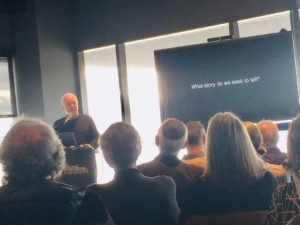
Robert Jan giving lecture
Further enhancing our experience, we could see the Statue of Liberty just behind him—a symbol of what’s good in our country, and the embodiment of millions of people’s hopes and dreams, ‘yearning to be free’.
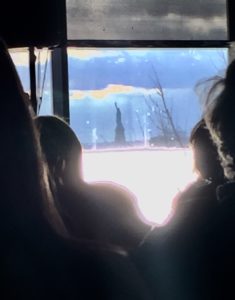
Statue of Liberty
When the lecture was finished, he opened the floor to questions. Excellent questions were asked, and (no surprise here) excellent answers were given. I was struck with the enormity of what we had just heard, and wasn’t sure that the audience understood how ‘big’ an experience they had just finished, so, impulsively, I raised my hand, when they announced, “One more question” and I was given the microphone.
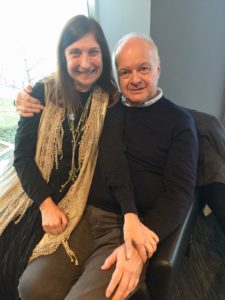
Ann and Robert Jan, at conclusion of the lecture
To the audience, I said, “You may not realize how great a privilege we have all just had—to hear this world-renown expert on Auschwitz explain HOW he conceived and organized this monumental exhibition! I have been to the actual Auschwitz in Poland many times, and I tell you honestly that I have never seen a fraction THERE of what is shown HERE in this exhibition! Now when you go back to view the exhibit, your experience will be enhanced by understanding, now, what was in the creator’s mind!”
“And to you, Robert Jan, because I know I’m supposed to ask a question, to you I ask: “Are you as proud of this accomplishment as you should be?”
He laughed modestly and admitted that he was duly proud, and then he shocked me by saying:
“Everything we do is based on the foundation of what has come before. This is no exception. Our work rests on the shoulders of giants. This, ladies and gentleman, is Ann Weiss and she is one of those giants.”
An amazing statement by an amazing giant, himself!
I am still blushing, but very proud, as I write these words to you.
Then the program ended and people flocked to the front. There was (of course) a big crowd around Robert Jan, but to my surprise, there was also a small crowd around me!
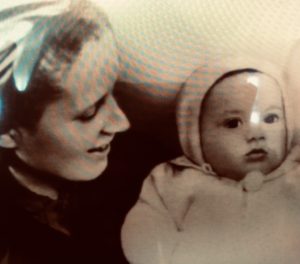
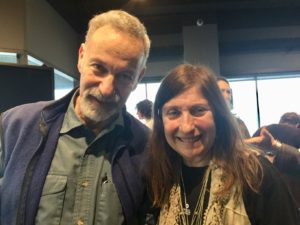
Dr. David Goldstein shows me photo of his mother’s cousin and her baby, shortly before they were murdered
I met Dr. David Goldstein, whose family came from the same region as many of the photos in my book and exhibition. He showed me a lovely photograph of a young mother and her sweet baby, and as I was admiring their innocence and beauty, he told me: “This happy mother was my mother’s first cousin, and tragically, she and her baby were murdered, not long after this photo was taken.” Without this photo, we would not even know that she or this precious baby ever lived.
I also met Lisa Jacobs, an art dealer in New York. She came over to tell me that her favorite part of the whole Auschwitz exhibit was the section featuring the personal photos from my book. After we spoke, I received a lovely email from Lisa, excerpts of which I share with you now (with her kind permission):
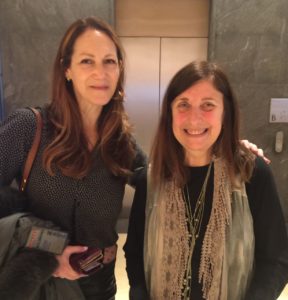
Lisa Jacobs, art dealer, and Ann
“I love the photos and what a special thing—a spark of life—they add to the exhibition. Going through the exhibition, one is so focused on how these Jews died, that we sometimes forget to reflect on how they lived, and the photos give us exactly that— a glimpse of life.”
From how perfectly she understood these photos, it’s as if Lisa read my mind—and looked into my heart—to pinpoint my exact motivation for my sharing these photos with the world. It is precisely that “spark of life” that compelled me to dedicate decades of my life to preserving the integrity of these photos. And ultimately, I have chosen to put the final punctuation on the people they were, not the victims they became. It is no wonder, then, why Lisa’s words mean so much to me.
The day was not over yet! As our last event of the 75th Anniversary, my friend, Dr. Emilie Passow, and I were rushed to hear Yitzhak Perlman perform on Monday night, at the world’s largest synagogue (with 3000 seats), at Temple Emanuel. What we didn’t realize—or at least, I did not—was that evening would also feature favorite songs performed (in Yiddish) from “Fiddler on the Roof,” directed by Joel Gray. Or that Tovah Feldshuh would read an excerpt from a devastating Holocaust memoir. Or that a legendary klezmer musician would finish the concert (sorry, I don’t know his name, only his reputation) with an electrifying ‘dueling fiddle’ performance with Yitzhak Perlman!
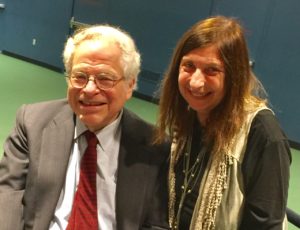
Yitzhak Perlman and Ann
All in all, it was an unforgettable day commemorating an unforgettable event!
Posted in From Ann | No Comments »